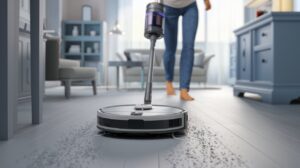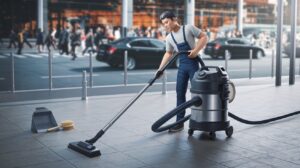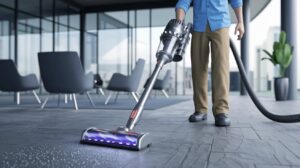How to Vacuum Effectively in High-Traffic Areas
Keeping high-traffic areas clean and well-maintained can be a challenge for busy households. These spaces, like hallways, entryways, and living rooms, endure constant foot traffic and accumulate dirt, pet hair, and debris more quickly than other parts of the home. To tackle this effectively, it’s crucial to have the right tools, techniques, and strategies in place.
In this guide, we’ll explore the best practices for vacuuming high-traffic areas, discuss the importance of regular maintenance, and share expert tips for a cleaner, healthier home.High-traffic zones in your home often suffer from wear and tear, leaving carpets and floors looking dull and dirty.
Effective vacuuming techniques can significantly extend the life of your flooring while maintaining a hygienic environment. Whether you’re managing heavy foot traffic, pet hair, or embedded dirt, this guide provides practical solutions to transform these busy areas into spotless, inviting spaces.

Understanding High-Traffic Areas
What Are High-Traffic Areas?
High-traffic areas are parts of your home that see the most activity. These spaces often include:
- Entryways: These are the first points of contact for outdoor dirt and debris. Shoes track in mud, dust, and even small rocks, quickly soiling the area.
- Hallways: As primary routes between rooms, hallways endure consistent movement that grinds dirt into flooring surfaces.
- Living Rooms: Daily activities like lounging, playing, and hosting guests create high levels of dirt and dust accumulation.
- Kitchens: Constant use and frequent spills make kitchens one of the dirtiest high-traffic areas.
Why Are High-Traffic Areas Harder to Clean?
High-traffic areas are uniquely challenging to maintain because they collect more dirt and debris than less-used parts of the home. Some factors contributing to this include:
- Constant Activity: Continuous movement in these spaces introduces dirt, crumbs, pet hair, and allergens, which quickly accumulate.
- Surface Variety: High-traffic areas may include carpets, hardwood floors, tiles, or rugs, each requiring specific cleaning techniques.
- Embedded Dirt: Heavy foot traffic can grind dirt deeper into carpet fibers or cause scratches and scuffs on hard flooring.
Impacts of Poor Maintenance
Neglecting high-traffic areas can lead to:
- Deterioration of Flooring: Carpets wear out faster, and hard floors become dull or damaged.
- Allergen Build-Up: Dust and pet hair can trigger allergies and affect indoor air quality.
- Unpleasant Appearance: Dirty floors and carpets create an uninviting atmosphere in your home.
By understanding the unique challenges and characteristics of high-traffic areas, you can develop a targeted cleaning approach. This ensures that your floors remain in excellent condition and your home stays fresh and welcoming.
Choosing the Right Vacuum for High-Traffic Areas
Types of Vacuums to Consider
Choosing the right vacuum cleaner is crucial for effective cleaning in high-traffic areas. The best vacuum for these spaces will depend on your specific needs. Here are some common types to consider:
- Upright Vacuums:
- Best for large areas and carpets.
- These vacuums often come with powerful suction and motorized brushes that effectively remove embedded dirt from carpets.
- Canister Vacuums:
- More versatile and easier to maneuver in tight spaces.
- Ideal for cleaning hard floors and reaching areas under furniture.
- Stick Vacuums:
- Lightweight and cordless options make these perfect for quick cleanups in high-traffic zones.
- Best suited for smaller spaces and light debris.
- Robotic Vacuums:
- Convenient for daily maintenance, especially in frequently used areas.
- While not ideal for deep cleaning, they help reduce dirt buildup.
- Handheld Vacuums:
- Perfect for spot cleaning, stairs, and upholstery.
- Compact and easy to use for quick touch-ups.
Key Features to Look For
When selecting a vacuum for high-traffic areas, prioritize these features:
- Strong Suction Power: Essential for pulling up dirt and debris embedded in carpet fibers or stuck to hard floors.
- HEPA Filters: These filters trap allergens like dust and pet dander, improving indoor air quality.
- Specialized Attachments: Tools like crevice tools, upholstery brushes, and pet hair attachments are invaluable for detailed cleaning.
- Adjustable Settings: Ensure your vacuum can transition smoothly between carpets, rugs, and hard flooring without causing damage.
Recommended Models for High-Traffic Areas
Some highly-rated vacuums for high-traffic areas include:
- Dyson Ball Animal 2: Known for its powerful suction and effectiveness on pet hair and thick carpets.
- Shark Navigator Lift-Away: A versatile option with detachable components for detailed cleaning.
- iRobot Roomba i7+: Excellent for automated daily cleaning, keeping dirt at bay in busy households.
Maintaining Your Vacuum for Peak Performance
Regular maintenance of your vacuum cleaner ensures it continues to perform optimally. Here are some tips:
- Empty Dust Bins or Replace Bags Frequently: Avoid letting the vacuum’s capacity fill up, as it reduces suction power.
- Clean or Replace Filters: This ensures your vacuum traps allergens effectively.
- Inspect Brushes and Rollers: Remove hair, string, or debris that might reduce efficiency.
- Check for Clogs: Periodically inspect hoses and nozzles for blockages that can hinder suction.
Investing in the right vacuum and keeping it well-maintained will make cleaning high-traffic areas significantly easier and more effective. The right tools can save time and ensure your floors and carpets remain in excellent condition.

Preparing High-Traffic Areas for Vacuuming
Decluttering the Space
Before vacuuming, take time to remove obstacles and clutter from the area. High-traffic zones are often littered with shoes, bags, toys, or other items. Clearing the space allows for thorough cleaning and prevents your vacuum from getting damaged by large or hard objects.
- Pick Up Loose Items: Remove items such as toys, shoes, or small furniture pieces.
- Shake Out Rugs: If there are rugs or mats in the area, shake them outside to remove loose dirt before vacuuming.
Dusting and Pre-Cleaning
Dust can settle on surfaces like baseboards, shelves, and furniture near high-traffic areas. Pre-cleaning these areas helps ensure that dust doesn’t fall onto the freshly vacuumed floor.
- Dusting Surfaces: Use a microfiber cloth or a duster to wipe down nearby surfaces.
- Sweeping Hard Floors: For areas with hard floors, sweeping can help pick up larger debris that might clog the vacuum.
Checking for Stains and Spills
In high-traffic areas, it’s common to find stains or sticky spots that vacuuming alone won’t address. Spot cleaning these areas before vacuuming ensures a more comprehensive clean.
- Spot Clean Carpets: Use a carpet cleaner or a mixture of water and mild detergent to tackle stains.
- Wipe Hard Floors: Clean sticky or oily spots with a damp cloth or appropriate floor cleaner.
Adjusting Vacuum Settings
Different surfaces in high-traffic areas may require specific vacuum settings to clean effectively without causing damage.
- Carpet Height Adjustment: For plush carpets, set the vacuum to a higher setting to avoid excessive resistance.
- Brush Roll Control: Turn off the brush roll when vacuuming hard floors to prevent scratches.
- Suction Power: Increase suction for thick carpets or areas with embedded dirt, and reduce it for delicate rugs.
Prepping for Deep Cleaning
If the area hasn’t been cleaned recently, consider a deep-cleaning session. Use a vacuum with a deep-cleaning mode or pre-treat carpets with a carpet shampoo to loosen embedded dirt.
By properly preparing high-traffic areas before vacuuming, you set the stage for a more effective and efficient cleaning session. This approach not only enhances the performance of your vacuum but also extends the cleanliness of these busy spaces.
Techniques for Effective Vacuuming in High-Traffic Areas
Use Proper Vacuuming Techniques
The way you vacuum has a significant impact on the cleanliness of high-traffic areas. To maximize your efforts, consider these proven techniques:
- Vacuum Slowly: Move the vacuum cleaner slowly over the surface to allow enough time for dirt and debris to be extracted.
- For carpets, go over each section multiple times, particularly in areas where foot traffic is heaviest.
- Use Overlapping Strokes: Ensure each pass overlaps the previous one slightly to avoid missing any spots.
- This technique is especially effective for removing dirt embedded in carpet fibers.
- Vacuum in Multiple Directions: Change the direction of your vacuuming strokes to lift dirt from different angles.
- For example, vacuum vertically, then horizontally, to loosen debris that may be stuck in the flooring.
Focus on High-Traffic Zones
Spend extra time on areas that see the most activity. These include:
- Entryways and Hallways: Use high-suction settings and repeat passes to remove stubborn dirt and debris.
- Living Room Carpets: Pay attention to spaces near seating areas and under furniture.
- Staircases: Use a handheld or specialized vacuum attachment to clean each step thoroughly.
Utilize Attachments for Detailed Cleaning
Vacuum attachments can help you reach corners, edges, and other tricky spots. Consider these tools:
- Crevice Tools: Ideal for cleaning tight spaces and edges.
- Brush Attachments: Perfect for removing pet hair and dust from furniture or baseboards.
- Upholstery Tools: Use these to clean fabric surfaces like couches and chairs in high-traffic areas.
Adjust Settings Based on Surface Type
Using the correct vacuum settings ensures effective cleaning without damaging your flooring. Adjust the settings for:
- Carpets and Rugs: Increase suction power and use a rotating brush for deep cleaning.
- Hardwood Floors: Turn off the rotating brush to prevent scratches and lower the suction if necessary.
Establish a Vacuuming Routine
Regular maintenance is key to managing high-traffic areas. Follow these guidelines:
- Daily Touch-Ups: Use a stick or robotic vacuum for quick cleanups in busy spaces.
- Weekly Deep Cleans: Perform a thorough vacuuming session at least once a week to maintain cleanliness.
- Spot Treatments: Address stains and spills immediately to prevent permanent damage.
By incorporating these techniques, you can achieve a deeper clean and maintain the appearance and hygiene of your high-traffic areas. This not only saves time in the long run but also helps protect your flooring and carpets from excessive wear and tear.
Importance of Regular Vacuum Maintenance
Prolonging Vacuum Longevity
Regular maintenance of your vacuum cleaner is essential to ensure its optimal performance over time. Here’s how you can extend its life:
- Clean Filters Frequently: Wash or replace filters as recommended by the manufacturer. Clogged filters reduce suction power and overall effectiveness.
- Inspect and Clear Brush Rolls: Hair, string, and other debris can get tangled in the brush roll. Regularly clean it to maintain efficiency.
- Check for Clogs: Examine hoses and nozzles for blockages that could impede airflow and suction.
Enhancing Cleaning Efficiency
A well-maintained vacuum ensures effective cleaning in high-traffic areas. Key practices include:
- Emptying Dust Bins: Do not let the bin or bag become too full, as it affects suction power.
- Replacing Worn Parts: Change belts, filters, or brushes when they show signs of wear and tear.
By keeping your vacuum in peak condition, you’ll enjoy better results and save money in the long term by avoiding frequent replacements.

Final Thoughts
Maintaining high-traffic areas requires effort and consistency, but the results are worth it. By choosing the right vacuum, preparing your space effectively, and mastering proper techniques, you can keep these busy zones clean and inviting. Regular vacuum maintenance and adherence to a cleaning routine ensure that your home remains fresh, healthy, and well-cared for.
Conclusion
Vacuuming high-traffic areas effectively requires the right tools, preparation, and techniques. By choosing a suitable vacuum, establishing a cleaning schedule, and following best practices, you can maintain a cleaner, healthier home. Remember to invest in preventive measures like door mats and rugs to minimize dirt buildup and extend the life of your carpets and floors. With these strategies, you’ll transform your high-traffic spaces into spotless, welcoming areas.